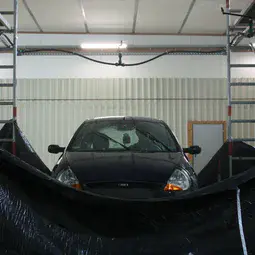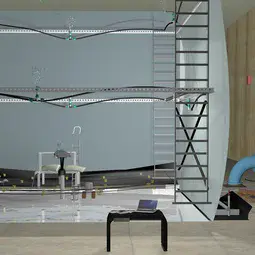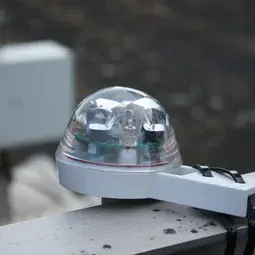Using moving cars to measure rainfall
Drivers on a rainy day regulate the speed of their windshield wipers according to rain intensity: faster in heavy rain and slower in light rain. This simple observation has inspired researchers from the University of Hanover in Germany to come up with ‘RainCars’, an initiative that aims to use GPS-equipped moving cars as devices to measure rainfall. The most recent results of the project are now published in Hydrology and Earth System Sciences, an open access journal of the European Geosciences Union (EGU).
Rainfall can be very variable across different parts of a region such as Northern Germany. Conventional rain gauges are accurate, but are often distributed too sparsely to capture much of this variation. Having good information about precipitation is important for flood prediction and prevention, for example.
“If moving cars could be used to measure rainfall the network density could be improved dramatically,” explains project-leader Uwe Haberlandt, who says the idea for RainCars emerged during a brainstorming session between geoinformatics researchers and hydrologists. With over 40 million cars in Germany alone, and with traffic increasing worldwide, the multi-disciplinary team might be onto a winner.
Now, with a lab equipped with a rain simulator, the researchers have been able to put their idea to the test. They placed cars with different wiper systems under the rain machine, which uses a sprinkler irrigation system with adjustable nozzles to simulate light to heavy rain, to find out exactly how wiper speed relates to rainfall intensity.
In one set of experiments, an individual in the car adjusted the wiper speed manually, depending on the windscreen visibility. “The experiments have shown that the front visibility is a good indicator for rainfall intensity,” says Ehsan Rabiei, Haberlandt’s collaborator and the paper’s lead author. But the measurements could depend on the person adjusting the wiper speed so may not be very reliable.
In another set of experiments, the team used the rain machine to test optical sensors that are installed in many modern cars to automate wipers. The sensors use a system of infrared laser beams that detect when drops of rain accumulate on the surface of the device. Each sensor reading corresponds to a specific amount of water, with more frequent readings corresponding to more intense rainfall.
“The optical sensors measure the rain on the windshield in a more direct and continuous manner so, currently, they would be the better choice for rain sensors in cars,” says Haberlandt.
The team could also test the effects of car movement on the measurements by placing the sensors on a rotating device, which simulates car speed, under the rain simulator. By knowing how the readings are affected by car speed, they can correct for this effect when using moving cars to measure rainfall.
But speed is not all that can alter the rain measurements, as Rabiei explains. “Our experiments so far were carried out in an ideal and controlled environment. In nature there are external effects like wind, spray from other cars or shielding trees that can affect the readings, and rainfall characteristics are different from the rain simulator.”
However, Haberlandt clarifies, “the value of using moving cars to measure rainfall is not about a higher accuracy of rainfall measurements but about a much higher number of measurement points.” In a Hydrology and Earth System Sciences study published in 2010, two of the team members showed that a high number of less accurate rain gauges gives more reliable rainfall readings than a low number of very accurate devices.
The researchers are already working on field experiments using cars to measure real rainfall in and around the city of Hanover. “There are some volunteers, a taxi company and a car company involved in the field experiments. We certainly would like to have some more people engaged.”
###
Please mention the name of the publication (Hydrology and Earth System Sciences) if reporting on this story and, if reporting online, include a link to the paper (http://www.hydrol-earth-syst-sci.net/17/4701/2013/hess-17-4701-2013.html) or to the journal website (http://www.hydrology-and-earth-system-sciences.net/).
More information
This research is presented in the paper ‘Rainfall estimation using moving cars as rain gauges – laboratory experiments’ published in the EGU open access journal Hydrology and Earth System Sciences on 28 November 2013.
Full citation: Rabiei, E., Haberlandt, U., Sester, M., and Fitzner, D.: Rainfall estimation using moving cars as rain gauges – laboratory experiments, Hydrol. Earth Syst. Sci., 17, 4701-4712, doi:10.5194/hess-17-4701-2013, 2013.
The 2010 study mentioned in the release is by U. Haberlandt and M. Sester: Areal rainfall estimation using moving cars as rain gauges – a modelling study, Hydrol. Earth Syst. Sci., 14, 1139-1151, 2010.
The team is composed of E. Rabiei, U. Haberlandt, M. Sester and D. Fitzner of the Leibniz University of Hanover, Germany.
The European Geosciences Union (www.egu.eu) is Europe’s premier geosciences union, dedicated to the pursuit of excellence in the Earth, planetary, and space sciences for the benefit of humanity, worldwide. It is a non-profit interdisciplinary learned association of scientists founded in 2002. The EGU has a current portfolio of 15 diverse scientific journals, which use an innovative open access format, and organises a number of topical meetings, and education and outreach activities. Its annual General Assembly is the largest and most prominent European geosciences event, attracting over 11,000 scientists from all over the world. The meeting’s sessions cover a wide range of topics, including volcanology, planetary exploration, the Earth’s internal structure and atmosphere, climate, energy, and resources. The 2014 EGU General Assembly is taking place is Vienna, Austria from 27 April to 2 May 2014. For information regarding the press centre at the meeting and media registration, please check http://media.egu.eu closer to the time of the conference.
If you wish to receive our press releases via email, please use the Press Release Subscription Form at http://www.egu.eu/news/subscribe/. Subscribed journalists and other members of the media receive EGU press releases under embargo (if applicable) 24 hours in advance of public dissemination.
Contact
Uwe Haberlandt
Institute of Water Resources Management,
Hydrology & Agricultural Hydraulic Engineering
Leibniz University of Hanover
Hanover, Germany
Phone+49-511-762-2287
EmailHaberlandt@iww.uni-hannover.de
Ehsan Rabiei
Institute of Water Resources Management,
Hydrology & Agricultural Hydraulic Engineering
Leibniz University of Hanover
Hanover, Germany
Phone+49-511-762-3278
EmailRabiei@iww.uni-hannover.de
Bárbara Ferreira
EGU Media and Communications Manager
Munich, Germany
Phone+49-89-2180-6703
Emailmedia@egu.eu
Links
- Scientific paper
- Journal – Hydrology and Earth System Sciences
- Read this press release in simplified language, aimed at 7–13 year olds, on our Planet Press site




